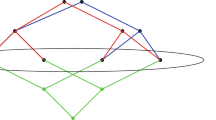Abstract
A packet-switching network is stable if the number of packets in the network remains bounded at all times. A very natural question that arises in the context of stability properties of such networks is how network structure precisely affects these properties. In this work we embark on a systematic study of this question in the context of Adversarial Queueing Theory, which assumes that packets are adversarially injected into the network. We consider size, diameter, maximum vertex degree, minimum number of disjoint paths that cover all edges of the network and network subgraphs as crucial structural parameters of the network, and we present a comprehensive collection of structural results, in the form of stability and instability bounds on injection rate of the adversary for various greedy protocols: —Increasing the size of a network may result in dropping its instability bound. This is shown through a novel, yet simple and natural, combinatorial construction of a size-parameterized network on which certain compositions of greedy protocols are running. The convergence of the drop to 0.5 is found to be fast with and proportional to the increase in size. —Maintaining the size of a network small may already suffice to drop its instability bound to a substantially low value. This is shown through a construction of a FIFO network with size 22, which becomes unstable at rate 0.704. This represents the current state-of-the-art trade-off between network size and instability bound. —The diameter, maximum vertex degree and minimum number of edge-disjoint paths that cover a network may be used as control parameters for the stability bound of the network. This is shown through an improved analysis of the stability bound of any arbitrary FIFO network, which takes these parameters into account. —How much can network subgraphs that are forbidden for stability affect the instability bound? Through improved combinatorial constructions of networks and executions, we improve the state-of-the-art instability bound induced by certain known forbidden subgraphs on networks running a certain greedy protocol. —Our results shed more light and contribute significantly to a finer understanding of the impact of structural parameters on stability and instability properties of networks.
Similar content being viewed by others
Author information
Authors and Affiliations
Corresponding authors
Rights and permissions
About this article
Cite this article
Koukopoulos, D., Mavronicolas, M., Nikoletseas, S. et al. The Impact of Network Structure on the Stability of Greedy Protocols. Theory Comput Syst 38, 425–460 (2005). https://doi.org/10.1007/s00224-004-1181-3
Received:
Revised:
Accepted:
Published:
Issue Date:
DOI: https://doi.org/10.1007/s00224-004-1181-3




